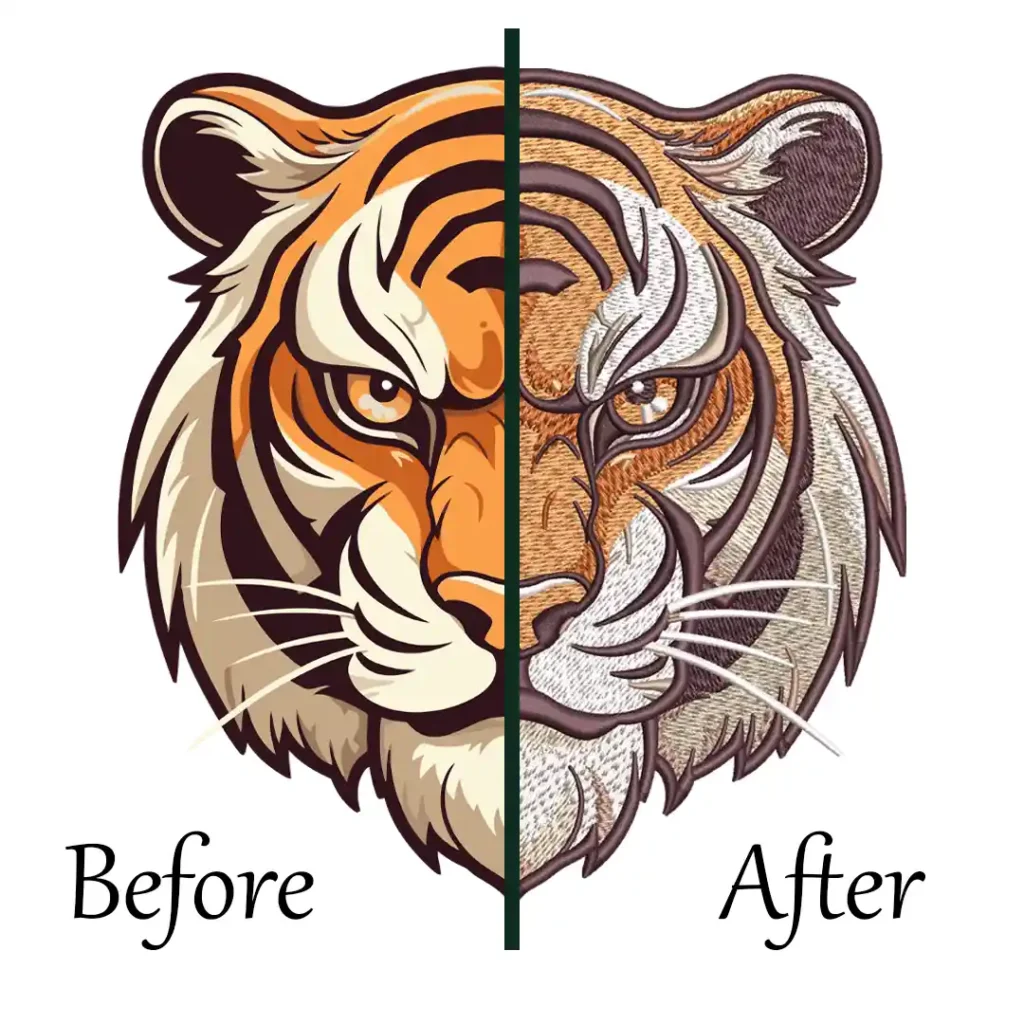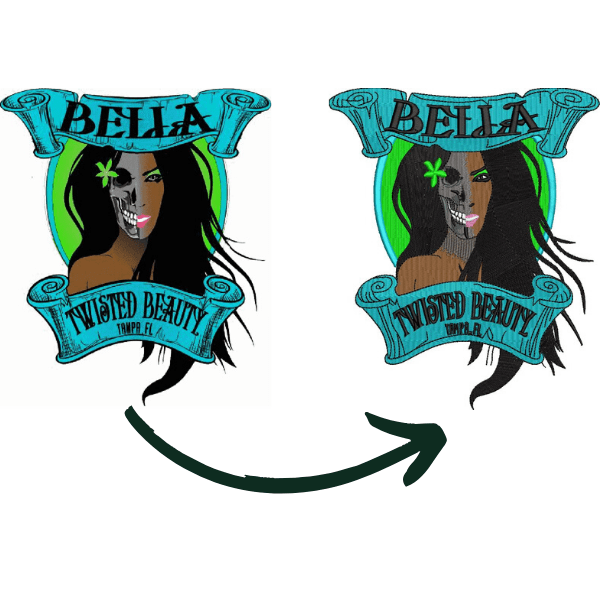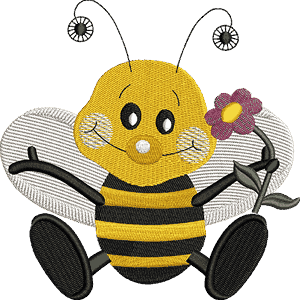AI in embroidery is making the process faster and easier. Before, people had to do everything by hand, which took a lot of time. Now, AI helps create designs, choose stitches, and fix mistakes automatically. This means embroidery looks better, takes less time, and wastes fewer materials. AI powered embroidery machines and software can adjust stitches, work on different fabrics, and handle big orders without much effort.
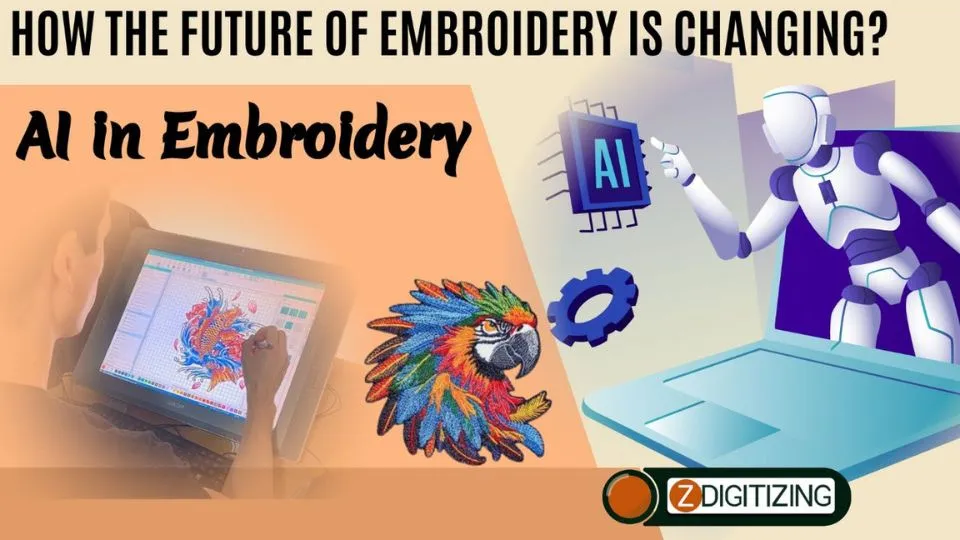
Even small businesses can use AI to save time and improve their work. As technology improves, embroidery will become even more advanced. AI will help people create new designs, work faster, and make embroidery more fun and simple for everyone. The future of embroidery technology is exciting—are you ready for it?
AI in Embroidery: How the Future of Embroidery is Changing?
What is AI Powered Embroidery?
It refers to the integration of artificial intelligence into embroidery machines and software to automate and enhance the embroidery process. It utilizes machine learning, automation, and smart algorithms to digitize designs, optimize stitch patterns, and improve efficiency.
This technology enables faster production, reduces errors, and allows for advanced customization, making embroidery more precise and accessible for both businesses and hobbyists.
AI vs. Traditional Embroidery: What’s the Difference?
Embroidery has changed a lot with the help of AI. Traditional embroidery needs skilled people to create designs and stitch them, while AI-powered embroidery machines can do these tasks automatically, making the process faster and more accurate.
Feature | AI-Powered Embroidery | Traditional Embroidery |
Design Creation | AI creates and improves designs automatically | Designs are made by hand using software |
Digitizing Process | AI converts images into embroidery patterns | A person must manually create the stitch patterns |
Precision & Accuracy | Very accurate with fewer mistakes | Mistakes can happen due to human error |
Production Speed | Faster because machines work on their own | Slower because people need to adjust settings |
Customization | AI allows quick changes to designs | Changes take more time and effort |
Error Detection | AI finds and fixes errors automatically | A person has to check and correct mistakes |
Material Optimization | AI adjusts stitching for different fabrics | Requires trial and error to find the right settings |
Labor Requirement | Fewer workers needed because AI handles most tasks | Skilled workers are needed for every step |
Cost Efficiency | Saves money by reducing waste and labor costs | More expensive due to high labor costs |
Scalability | Easy to produce large orders | Takes longer to make a lot of items |
What is the Role of AI in Embroidery Digitizing?
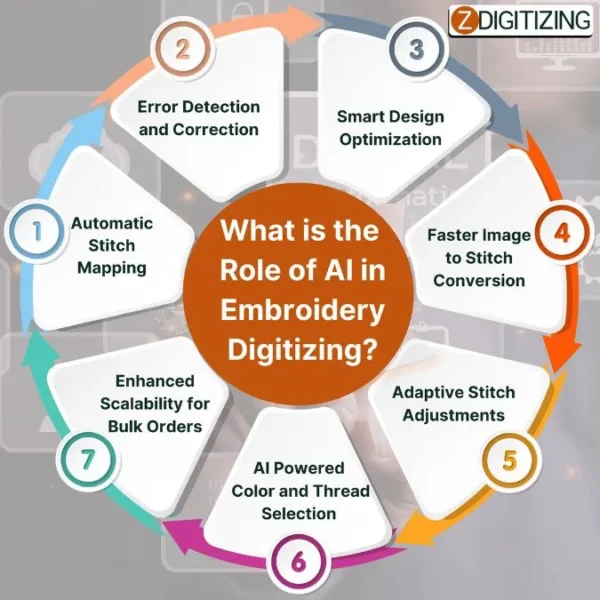
AI is making embroidery digitizing faster, more accurate, and easier for everyone. It automates complex tasks, reduces errors, and improves the overall quality of embroidery designs.
With AI-powered automated digitizing, even complex patterns can be converted into stitch-ready files with precision, making embroidery more efficient and accessible.
- Automatic Stitch Mapping
- Error Detection and Correction
- Smart Design Optimization
- Faster Image to Stitch Conversion
- Adaptive Stitch Adjustments
- AI Powered Color and Thread Selection
- Enhanced Scalability for Bulk Orders
1. Automatic Stitch Mapping
AI analyzes a design and automatically assigns the best stitch types and directions. This eliminates the need for manual adjustments and ensures a smooth and precise embroidery outcome. It also optimizes stitch density to match the fabric type, reducing thread wastage.
2. Error Detection and Correction
AI in embroidery can detect mistakes in the digitized design before stitching begins. It identifies issues like overlapping stitches, incorrect stitch density, or uneven patterns and corrects them automatically. This helps reduce errors that might cause fabric damage or uneven embroidery.
3. Smart Design Optimization
AI enhances embroidery designs by adjusting stitch flow, density, and sequencing for a more polished look. It ensures that complex designs are digitized efficiently, reducing unnecessary stitches while maintaining high-quality output.
4. Faster Image to Stitch Conversion
With AI, converting an image into an embroidery file takes just a few clicks. The system automatically detects edges, fills areas with the right stitch types, and converts the design into a machine-readable format within seconds, saving a lot of time.
5. Adaptive Stitch Adjustments
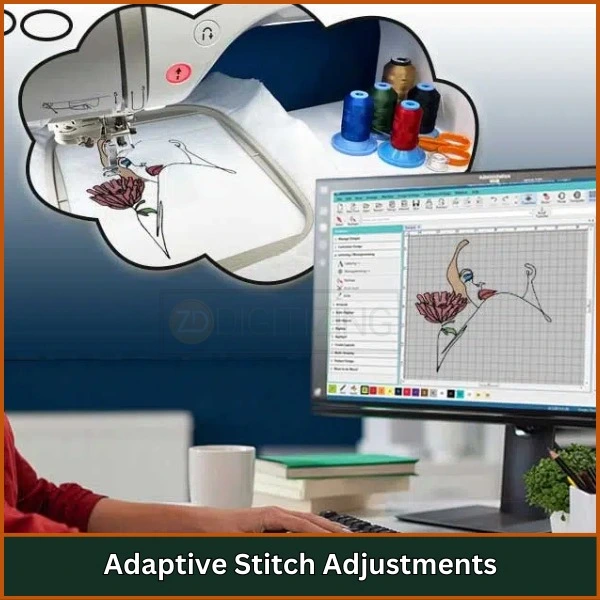
AI helps embroidery machines adjust stitches according to the type of fabric being used. Different fabrics, like cotton, silk, or denim, need different stitching techniques to ensure smooth and high-quality embroidery.
AI detects the fabric’s thickness, texture, and stretchability and automatically adjusts stitch density, tension, and length to prevent issues like puckering, loose threads, or fabric distortion.
For example, silk is delicate and requires lighter stitches, while denim is thick and needs stronger, tighter stitches to hold the design properly. AI ensures that each fabric gets the right stitch settings without the need for manual adjustments. This makes embroidery easier, faster, and more professional, reducing mistakes and ensuring that the final design looks perfect on any fabric type.
6. AI Powered Color and Thread Selection
AI suggests the best thread colors that match the original image or design. It can even adjust color contrast to improve design visibility on different fabric backgrounds, helping embroiderers achieve the best visual results.
7. Enhanced Scalability for Bulk Orders
AI-powered embroidery digitizing allows businesses to scale up production efficiently. It can generate multiple versions of a design for different fabric types and machine formats, making it easier to handle bulk orders without compromising quality.
What is the Future of AI in Embroidery?
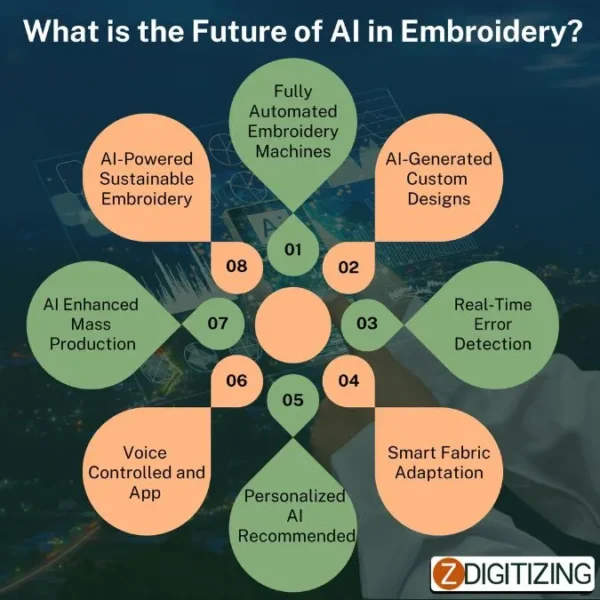
AI is set to revolutionize embroidery by automating processes, enhancing design precision, and making customization easier.
As AI technology evolves, it will bring smarter, faster, and more efficient embroidery solutions for businesses and individuals.
- Fully Automated Embroidery Machines
- AI-Generated Custom Designs
- Real-Time Error Detection and Self Correction
- Smart Fabric Adaptation
- Personalized AI Recommendations
- Voice Controlled and App Based Embroidery Machines
- AI Enhanced Mass Production
- AI-Powered Sustainable Embroidery
1. Fully Automated Embroidery Machines
AI will enable embroidery machines to work independently, handling everything from design selection to stitching without human intervention. These machines will adjust settings automatically, reducing manual effort and ensuring consistent, high-quality embroidery.
2. AI Generated Custom Designs
With AI, users will be able to generate unique machine embroidery designs based on preferences, colors, and themes. AI-powered software will analyze patterns, suggest improvements, and create digitized files instantly, making custom embroidery faster and more creative.
3. Real Time Error Detection and Self-Correction
AI will help embroidery machines detect errors like skipped stitches, thread breaks, or uneven tension in real time. The machine will automatically correct these issues by adjusting stitch density or rethreading, reducing material waste and improving efficiency.
4. Smart Fabric Adaptation
AI-powered embroidery machines will recognize different fabric types and adjust stitch patterns, thread tension, and needle settings accordingly. This will allow smooth embroidery on various materials like silk, denim, leather, and stretch fabrics without manual trial and error.
5. Personalized AI Recommendations
Future AI powered embroidery software will make embroidery design easier by providing smart suggestions based on past projects. It will recommend the best color combinations, stitch types, and design modifications, helping users create high-quality embroidery with minimal effort..
6. Voice Controlled and App Based Embroidery Machines
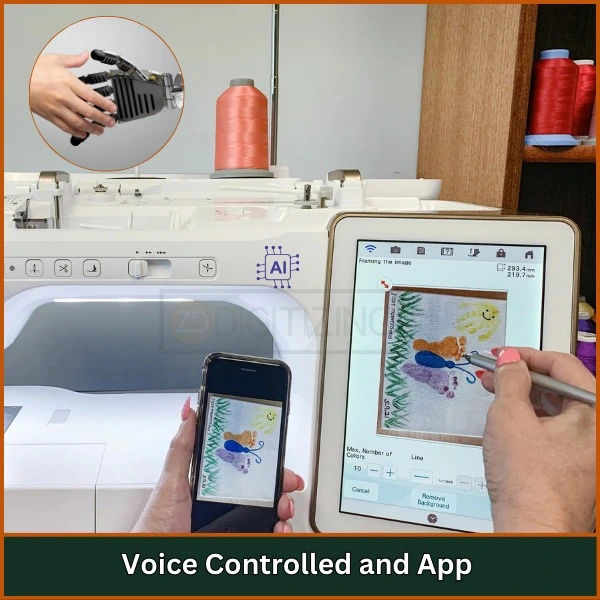
AI is making embroidery machines smarter by adding voice control and mobile app integration. With voice commands, users can start, stop, or pause embroidery without touching the machine, making the process easier.
Mobile apps allow users to adjust settings, change designs, and monitor progress remotely. If there’s a thread break or error, the app sends alerts, so users can fix issues quickly.
This technology saves time, reduces manual work, and makes embroidery more convenient, even for beginners.
7. AI Enhanced Mass Production
Factories and businesses will benefit from AI-powered embroidery machines that optimize large-scale production. AI will streamline workflows, manage multiple machines, and ensure consistent quality across bulk orders, reducing time and labor costs.
8. AI Powered Sustainable Embroidery
AI will contribute to eco-friendly embroidery by minimizing thread wastage, optimizing machine energy consumption, and suggesting sustainable materials. This will help embroidery businesses adopt greener production methods while maintaining high efficiency.
Challenges and Limitations of AI in Embroidery
While AI is transforming embroidery by making it faster and more precise, there are still some challenges and limitations. Understanding these issues can help businesses and embroiderers prepare for potential drawbacks.
- High Initial Investment – AI-powered embroidery machines and software can be expensive to implement.
- Learning Curve for Users – Traditional embroiderers may need training to adapt to AI technology.
- Dependence on Technology – If the system crashes or malfunctions, production may halt.
- Limited Creative Control – AI-generated designs may lack the artistic touch of human digitizers.
- Software and Hardware Compatibility Issues – AI embroidery software may not work with all existing machines.
- Data Security Risks – AI systems store digital designs, which can be vulnerable to cyber threats.
- Lack of Customization in Some Cases – AI may struggle to interpret complex hand-drawn or unique designs.
- Ongoing Maintenance and Updates – AI-powered machines require regular software updates and maintenance for optimal performance.
Conclusion
AI in embroidery is making everything faster, easier, and more accurate. From creating designs to stitching, AI is helping businesses and individuals save time and improve quality. As technology grows, embroidery will become even better, offering more creative and efficient ways to bring designs to life.
If you need professional embroidery digitizing, ZDigitizing is here for you! We offer high-quality digitizing at the best prices, with super-fast turnaround time and guaranteed quality. You can also preview your design before finalizing it to make sure it’s perfect.
First time ordering from us? Get 50% off your first order! Try ZDigitizing today and see the difference!
FAQs
Embroidery is evolving with new trends and technology. 3D puff embroidery will remain popular in 2025, offering bold, raised designs that stand out visually and feel unique. Minimalist logos with clean and simple designs will also continue to be in demand, especially among sports and lifestyle brands.
Yes, AI can generate embroidery files by converting digital images into stitch-ready formats. AI-powered software can automatically map stitches, adjust densities, and optimize thread paths, making digitizing faster and more efficient than manual methods.
Yes, modern embroidery machines can operate with minimal human input. AI-powered embroidery machines can digitize designs, adjust settings, and stitch patterns without constant supervision, allowing businesses to produce high-quality embroidery efficiently.
New embroidery technologies include AI-driven digitizing software, automated multi-needle machines, and 3D puff embroidery techniques. These advancements help improve design accuracy, production speed, and customization, making embroidery easier and more innovative than ever before.


